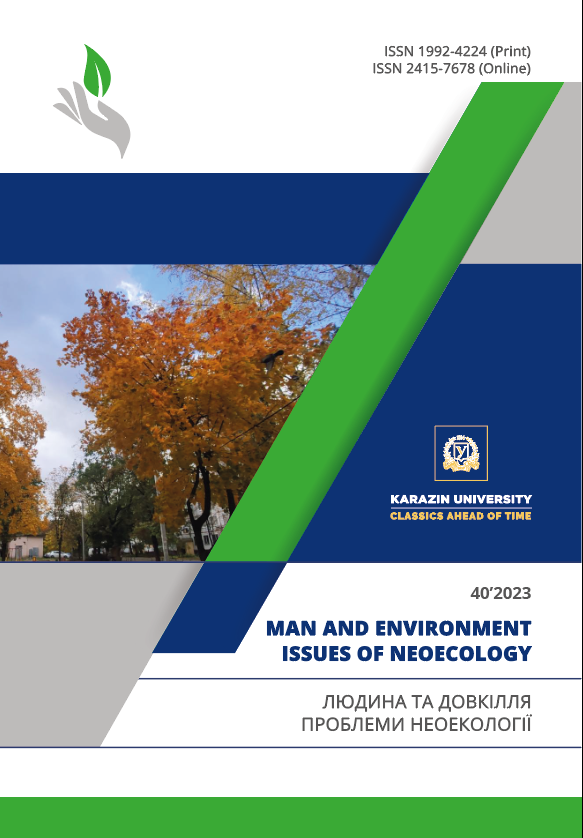The "Knyagynya" tract as a center for the preservation of the phytological identity of the Eastern Podillia
Abstract
Purpose. To describe the phytodiversity of the "Knyaginya" Tract - a complex natural monument of national importance.
Methods. Field, cartographic, analytical, descriptive, comparative, expeditionary, bioindicative, statistical, systemic, biomonitoring.
Results. The diversity of phytocenoses of the "Knyaginya" Tract - a complex natural monument of national importance with an area of 53 hectares, located within the boundaries of the Pischanska settlement territorial community of the Tulchyn district of the Vinnytsia region - was established. The importance of the object of the nature reserve fund for the formation of the regional econetwork of Eastern Podillia was clarified. The species richness of various phytocenoses of the relatively small area of the studied object is substantiated. 527 species of higher vascular plants were identified, of which 440 are autochthonous and 87 are adventitious, which is 43.5% of the total phytodiversity of Eastern Podillia, which includes 1210 species. In terms of the number of species, the studied area is one of the most valuable reference areas of the region's plant gene pool.
Conclusions. In order to preserve the rare phytodiversity of Eastern Podillia, it is proposed to expand the boundaries of the complex natural monument "Knyaginya" Tract.
Downloads
References
Mudrak, O.V. (Ed.). (2015). Standards of nature of Vinnytsya. Vinnytsia: TOV “Konsol” (In Ukrainian)
Dyadchenko, V.V., Karakurchi, G.., Petruhin, S. Y., Dyadchenko, A. V., Kochanov, E. O.,Maksymenko, N.V., & Shumilova, A.V. (2016). Assessment of Conformity Environmental Territories of European Countries to Criteria of IUCN. Visnyk of V. N. Karazin Kharkiv National University Series «Еcоlogy», (15), 21-28. Retrieved from https://periodicals.karazin.ua/ecology/article/view/7892
Mudrak, O., & Ovchinnikova, Y. (2022). Sozological assessment of the biotic diversity of Eastern Podillia in the context of the region's sustainable development strategy. Scientific bulletin of the Vinnytsia Academy of Continuing Education. The series "Ecology. Public management and administration", 2, 8–21. https://doi.org/10.32782/2786-5681-2022-2.02
Shinder, O.I. (2008). Geographic distribution and habitat conditions of Adonis vernalis L. (Ranunculaceae Juss.) in the territory of Murafsky Tovtr]. Introduktsiya roslyn – Introduction of plants. 2008. No. 3. P. 29–33.
Shinder, O.I. (2009). Distribution and population status of Crocus reticulatus Stev. ex Adams (Iridaceae) and Tulipa quercetorum Klok. & Zoz (Liliaceae) on the territory of Eastern Podillia. Ukrainian botanical journal, 66(4), 489–497.
Shinder, O.I. (2011). Floristic diversity of the Kukulyansky tract (Vinnytsia region). Proceedings of the international scientific conference Karazin natural history studies, Kharkiv: Karazin KhNU 137–139.
Muzychenko, O. S., & Veselukha, T.V. (2017). Nature-reserve fund Kiverzivsky district of Volyn region. Man and Environment. Issues of Neoecology, 27(1-2), 86-94. Retrieved from https://periodicals.karazin.ua/humanenviron/article/view/9174
Boyarin, M. V., & Savchyk, L. A. (2017). Ecological description of rare species of plants of Cheremskyi nature reserve included in international Red Lists. Man and Environment. Issues of Neoecology, 27(1-2), 77-85. Retrieved from https://periodicals.karazin.ua/humanenviron/article/view/9173
Mudrak, O.V., Ovchynnykova, Yu.Yu., Mudrak, G.V., & Nagornyuk, O.M. (2018). Eastern Podilia as a Structural Unit of a Pan-European Environmental Network. Journal of Environmental Research, Engi-neering and Management 2018. Vol. 74. № 3. Р. 55–63. DOI: https://doi.org/10.5755/j01.erem.74.3.21521
Maksymenko, N. V., Fediai, V. A., & Dobronos, P. A. (2020). Spatial-Temporal Assessment of Formation of Nature Reserve Fund of Sumy Region. Man and Environment. Issues of Neoecology, 34, 121-132. https://doi.org/10.26565/1992-4224-2020-34-12
Yacentyuk, Y. V. Ekomerezha Vinnytsʹkoyi oblasti [Econetwork of Vinnytsia region]. Vinnytsia: PE "TD "Edelweiss and K". 2011. 128 p.
Yatsentyuk, Y. V., Kanskyy, V. S., & Ataman, L. V. (2020). The Recovery Territories of the Ecological Network in Zhmerinsky District of Vinnytsia Region. Man and Environment. Issues of Neoecology, 33, 57-67. https://doi.org/10.26565/1992-4224-2020-33-05
Burianyk, O. O., Karabiniuk, M. M., & Gostiuk, Z. V. (2021). Nature Reserve Fund of Skoliv Beskids: Landscape Differentiation, Structure and Perspectives. Man and Environment. Issues of Neoecology, 35, 83-92. https://doi.org/10.26565/1992-4224-2021-35-08
Маyorova O. Y., Kovalchuk, I. I., Prokopiak , M. Z., & Kryzhanovska, M. A. (2021). The Nature Reserve Fund of Khmelnytskyi Region in the Context of the Emerald Network Developemnt . Man and Environment. Issues of Neoecology, 35, 131-139. https://doi.org/10.26565/1992-4224-2021-35-12
Zahriichuk , V. F. (2022). Natural reserve fund of the western part of the North Pokuttya highland: structure and problems and prospects of optimization. Man and Environment. Issues of Neoecology, 37, 104-122. https://doi.org/10.26565/1992-4224-2022-37-10
Brusak , V. P., & Popyk , D. I. (2022). Nature reserve foundation of Skibovy Gorgany: structure and prospects of optimization (Ukrainian Carpathians). Man and Environment. Issues of Neoecology, 37, 91-103. https://doi.org/10.26565/1992-4224-2022-37-09
Didukh, Ya.P. & Sheliag-Sosonko, Yu.R. (2003). Geobotanical zoning of Ukraine and adjoining territo-ries. Ukrainian Botanical Journal, 60(1), 6–17 (In Ukrainian)
Marynich, O.M. & Shishchenko, P.G. (2005). Physical geography of Ukraine. Кyiv: Znannya (In Ukrainian)
Didukha, Ya.P. (Ed.). (2009), Red book of Ukraine. Plant world. Kyiv: Global consulting (In Ukrainian)
Copyright (c) 2023 Мудрак О. В., Березовська Р. Л., Мудрак Г. В.

This work is licensed under a Creative Commons Attribution 4.0 International License.
Authors reserve the right of attribution for the submitted manuscript, while transferring to the Journal the right to publish the article under the Creative Commons Attribution License 4.0 International (CC BY 4.0). This license allows free distribution of the published work under the condition of proper attribution of the original authors and the initial publication source (i.e. the Journal)
Authors have the right to enter into separate agreements for additional non-exclusive distribution of the work in the form it was published in the Journal (such as publishing the article on the institutional website or as a part of a monograph), provided the original publication in this Journal is properly referenced
The Journal allows and encourages online publication of the manuscripts (such as on personal web pages), even when such a manuscript is still under editorial consideration, since it allows for a productive scientific discussion and better citation dynamics (see The Effect of Open Access).





